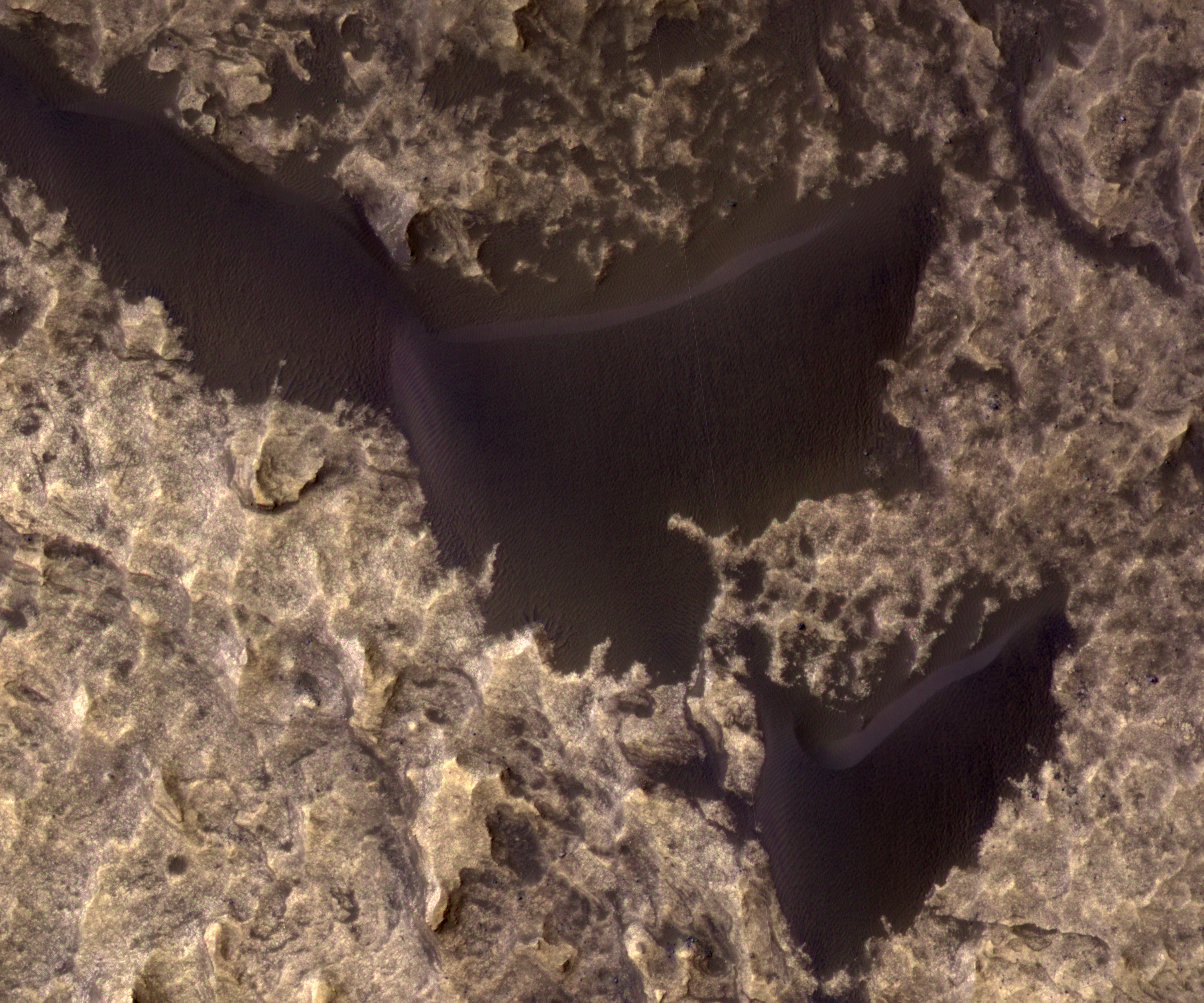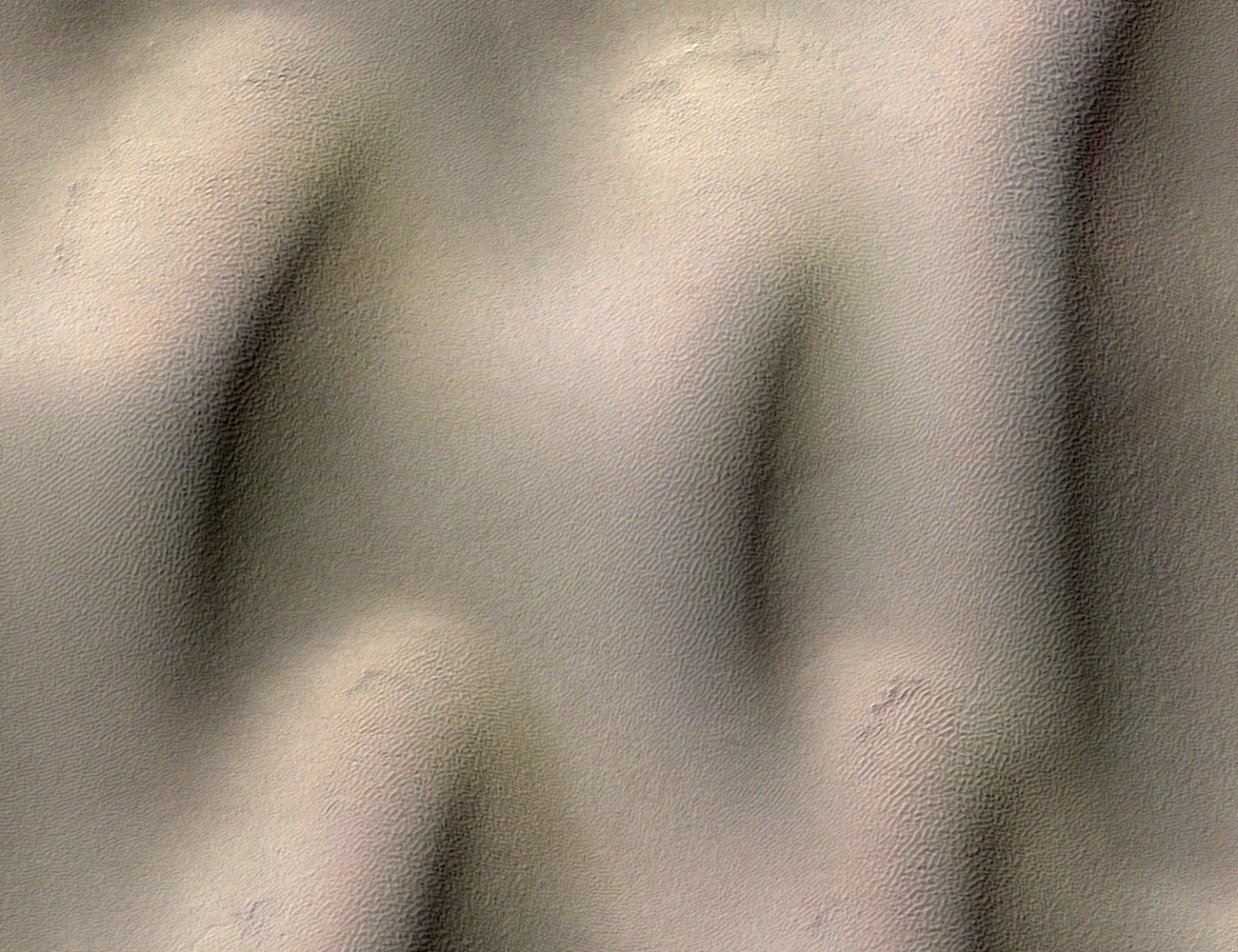HiRISE images
When dunes vary in color

Nov. 11, 2019
It's Veterans Day in the US today. For some it's another day of work. For others it's a day to spend with the family. For most, we honor those who have served in our armed forces. I'm at work today, along with what I call the "holiday skeleton crew" - those of us at the SETI Institute who come to work on some holidays because our schedules allow it and because this is where we want to be.
It's been a while since I posted a HiRISE picture. I've been really busy with work, and I've also been fighting... read more ❯
Wind and sun on the dunes

Oct. 1, 2019
It's spring in the northern hemisphere on Mars. Actually, as of today, it's pretty close to northern summer solstice, but the recent crop of released HiRISE images mostly come from the spring season.
Northern polar dunes on Mars get covered in winter frost every year. That frost sublimes away, bit by bit, as the sun rises higher and the days grow longer throughout northern spring. It's a fun process to watch, like in this image:
The image is tilted a bit... read more ❯
How many dust devils can you find?

Aug. 28, 2019
So I was wasting time looking for dune fields on Mars and I came across a great CTX image that's just riddled with dust devil tracks. Most of the time that's all you see, but sometimes you can spy a dust devil or two.
And once in a great while you catch the dust devil engine at maximum. Below is the browse image for one such example.
OK, right, you can't see any spectacular dust devils looking at this alone. That's because... read more ❯
Dunes or bacteria?

Aug. 21, 2019
Trolling through the HiRISE image catalog, I came across some dunes that look a bit like bacteria.
(Well okay, they look like some sort of microbe to my eye, which is highly untrained in looking at microbes, so if that's your thing then go ahead and shake your head. I'll wait. Ready to move on?)
(On the other hand, if you have a pic of microbes that look like this, let me know.)
(Oh and I want to give a shout-out to a new Youtube channel Journey to the Microcosmos, which is absolutely mesmerizing.)
Bacteria or dunes? Image... read more ❯
Bask in Mars' beauty, because you can

August 5, 2019
It's been a while since I posted anything. Not because I didn't want to, but because I'm involved in so many projects that many things I love are being shoved aside for whatever has to be dealt with at any given moment.
It was a rough weekend and end of the week in the US - there have been a few quite prominent mass shootings. I'm not going to get political about it here. I'm just going to share my personal escape route from it all: gorgeous Mars. So. Here are a couple of scenes from Ius Chasma, one... read more ❯
Old dunes and new dunes

On Earth, really old windblown dunes don't usually survive long enough to become part of the geologic rock record. Dunes are made of unconsolidated sand, which is easily eroded by just about anything, so it takes special circumstances to keep dunes around. Most of the dunes preserved in Earth's geological layers are just the bottom fraction of the dunes - the tops were cut off (quite often by other dunes!).
That same process has happened on Mars too. But in a few locations, something special has happened: entire dunes have been preserved. That must mean that the dunes formed and then... read more ❯
Why does Lori study dunes on Mars?

When I look for something to blog about, I usually go to the HiRISE catalog to see if there are any new pictures that I find interesting.
Today this lovely dune field caught my eye:
HiRISE images are about 6 km (3.7 mi) across, so that dune field is about 4 km (2.5 mi) wide and 7 km (4.3 mi) long. If you look carefully you'll see that it's a little bit weird. The entire dune field is surrounded by a crisp-edged area of sand that isn't shaped into dunes (I call it an... read more ❯
Wind at the Mars InSight landing site

InSight landed in Elysium Planitia on 26 November, 2018, about a month ago as of this writing.
Pictures show that it's a flat place, with small scattered rocks lying around. Unlike in Gale crater, where Curiosity is slowly working its way up the side of a 5 km mountain with a spectacular view of the crater rim, InSight's landing spot is a little boring.
InSight's view in Elysium Planitia
Curiosity's view in Gale crater
Image Credit: NASA/JPL-Caltech
Image Credit: NASA/JPL-Caltech/MSSS
In a way, though, that's interesting, if simply for the contrast between the two sites.
Despite this big difference in relief, there is one thing the sites... read more ❯
Pretty little dune field in Noachis Terra

Noachis Terra is an ancient terrain on Mars, located in the mid southern highlands. It's the home of many dune fields, big and small. Here's a fairly small one.
You can't see it, but this is the floor of an unnamed crater. If you follow the link to the CTX image, you'll see that there's a much larger dune field to the south, trapped in a pit eroded into the floor of the... read more ❯
Complexity

Being a geomorphologist and reading a landscape is a little bit like being one of the forensic scientists on CSI (or choose your own favorite investigative show). A Mars geomorphologist usually has to do this entirely by remote sensing. So now imagine that forensic scientist trying to piece together a crime scene by peering at images taken by a drone. On Earth, at least, a geologist can head out to the actual field site and take samples and do some honest labwork to figure out how ancient landscapes formed. Planetary scientists aren't often so lucky (although we do use analog... read more ❯